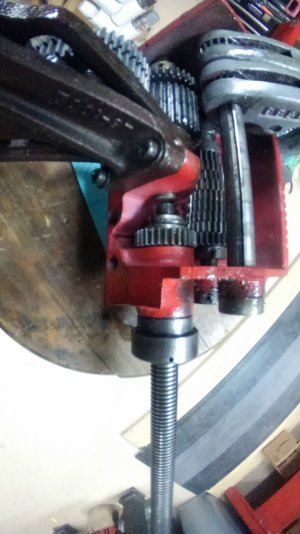The lead screw on my 12"x52 Craftsman is so worn that the half nut won't even stay engaged. The thread faces have been worn down to knife edges. I fixed it initially by filing out a small amount of material from the end of elliptical slots on the half nut carrier. This allowed the nut to clamp tighter, and worked for a while. But, it only takes it to jump a thread on the leadscrew once while trying to single point a 20tpi thread as the last operation of a part to send you looking for solutions.
My solution was to flip the lead screw around, since the tailstock end looked practically brand new. The threaded end, down at the tailstsock, slid into the headstock side receptacle far enough to leave .850" between the leadscrew and bearing on the tailstock end. I chucked the leadscrew, and drilled a 1/4" into the headstock end. Then I took a 1/2"x20 bolt, and turned it so that it had a 1/2" long pin where the head used to be, and drove it into the hole in the leadscrew. That extended the leadscrew, and provided for something to ride in the bearing. I then cut down a piston wrist pin from a Corvair engine I blew up to take up the slack area between the end of the lead screw and the bearing.
I don't rightly know what the threaded end of the leadscrew is riding against down inside that receptacle. Maybe I should stick a brass washer in there?
My solution was to flip the lead screw around, since the tailstock end looked practically brand new. The threaded end, down at the tailstsock, slid into the headstock side receptacle far enough to leave .850" between the leadscrew and bearing on the tailstock end. I chucked the leadscrew, and drilled a 1/4" into the headstock end. Then I took a 1/2"x20 bolt, and turned it so that it had a 1/2" long pin where the head used to be, and drove it into the hole in the leadscrew. That extended the leadscrew, and provided for something to ride in the bearing. I then cut down a piston wrist pin from a Corvair engine I blew up to take up the slack area between the end of the lead screw and the bearing.
I don't rightly know what the threaded end of the leadscrew is riding against down inside that receptacle. Maybe I should stick a brass washer in there?


